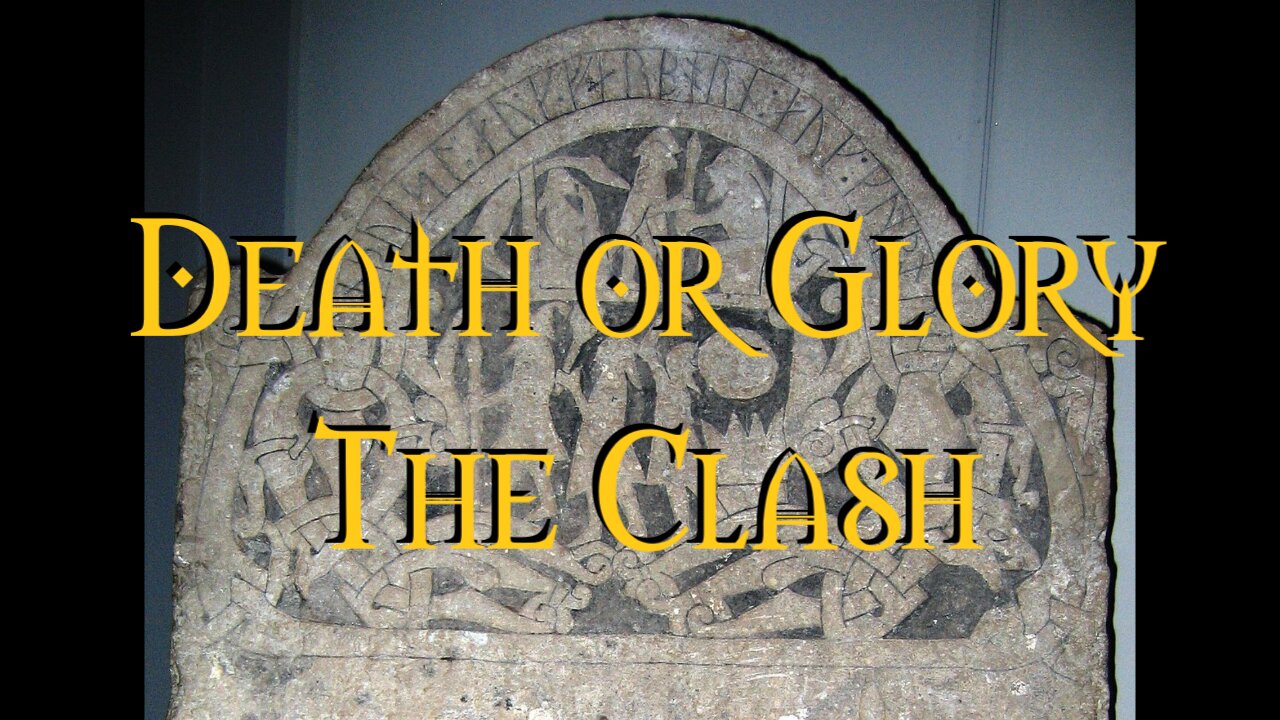Premium Only Content

Death or Glory The Clash
"Death or Glory" is the motto of The Royal Lancers, an armored cavalry regiment in the British 1st Armored Infantry Brigade. It's one of the best known mottoes in England. Joe and the lads were cocking a snook at the myth of the noble, honorable military in this song.
The amusing lyric, "he who f--ks nuns will later join the church" is a metaphor for teenagers who rebel against authority growing up and becoming authority figures themselves, becoming all that they fought against before.
Journalist Lester Bangs believed the lyric about a "gimmick-hungry yob" related specifically to Sham 69 lead singer Jimmy Pursey, although as The Clash were friends with Pursey and the band this unlikely and is more likely a generic reference to bands trying to make a quick buck out of rock music.
Freyr is a member of the Vanir tribe. There are two tribes of gods in Norse mythology, the Vanir and the Aesir. The Vanir are generally considered fertility gods, while the Aesir are known as warrior gods.
As such, it makes sense that Freyr is known as a god of fertility and peace. He is also strongly associated with the sun, which gives us a good idea of his importance. Across many cultures, sun gods tend to be at, or close to, the top of their respective pantheons.
Freyr is described in old poems as being first among the gods when it came to reputation. Apparently, no one disliked him among all the people.
Freyr is usually depicted as a virile, muscular man with long flowing hair. Often, he is carrying a sword and he is almost always accompanied by his gigantic golden-bristled boar, Gullinbursti. Since Freyr is both the son of the ocean god and himself the sun god, we can see both of those themes in artwork that depicts him. Some images will show him holding an antler, since in one of his myths he is forced to give his sword away and must make do with an antler instead. As a god of fertility, Freyr is sometimes shown as a man who is very well-endowed.
Like nearly all of the Norse gods, Freyr is part giant – in this case, on his mother’s side. He’s the son of the frost giantess, Skadi, and the god of the sea, Njord. He is also the twin brother of his equally beautiful and famous sister Freyja. His sister rules over much that Freyr does, but additionally presides over death and war.
Some accounts do not identify Skadi as Freyr’s mother, but rather as the unnamed sister of Njord. In that case, Freyr’s mother would also be his aunt, but that sort of marriage was not at all uncommon among the gods.
After Freyr was born, he was given a gift to commemorate his first tooth, which is a Norse tradition. That gift was Alfheim, one of the nine worlds in the branches of Yggdrasil and home to the elves. It’s not clear if this actually makes Freyr the ruler of Alfheim, but it certainly was his home.
Over the course of his life, Freyr came into possession of many treasures, much as you’d expect for a god of wealth.
One of his greatest treasures was his ship, Skithblathnir. This ship was an amazing magical vessel that always had a favorable wind, no matter what. That, however, was not its greatest trick: Skithblathnir could be folded up into a tiny object that could fit inside a bag. This amazing ship let Freyr travel the seas easily. On land he wasn’t forced to go on foot, either. He had a magnificent chariot drawn by boars that brought peace wherever it went.
One of the most famous stories in Freyr’s history tells us how he fell in love. After the war between the Aesir and the Vanir was over, Freyr became one of the hostages who joined the Aesir. One day, he decided to sit on Odin’s throne, which had the power to show the user anything in the nine worlds of Yggdrasil.
Since he is such a prominent god in Norse mythology there are extensive writings about him and his deeds. As with most Norse mythology, we can read about him in the Prose Edda and Poetic Edda. There are many archeological forms of evidence that Freyr has been worshipped.
Worship of Freyr is especially associated with Sweden, so much so that it is believed the Swedish royal house directly descends from him. Clearly, he is woven deeply into the culture and history of the Scandinavian and Germanic people, a radiant god whose presence can still be felt today in the art and stories of that part of the world.
-
 16:00
16:00
Psychological operations
12 days agoShut 'Em Down Bring Tha Noize Ft. Anthrax He Got Game Public Enemy
67 -
 10:58
10:58
Degenerate Jay
22 hours ago $7.19 earnedThe Rejected Deadpool And Wolverine Joke That Was Too Far For Disney
86.2K5 -
 13:00
13:00
Dermatologist Dr. Dustin Portela
14 hours ago $3.38 earnedAnother Insurance Company Harming Patients - Doctor Explains
41K4 -
 52:32
52:32
Survive History
21 hours ago $5.57 earnedCould You Survive in King George's Redcoats During the Jacobite Rising?
34.3K5 -
 17:53
17:53
Fit'n Fire
19 hours ago $2.06 earnedA Rifle for the Family -- BCM MK2 BFH and Gunnr Optics Odin 1-10x28mm LPVO
24K2 -
 1:03:52
1:03:52
GrassRootsWarriorNetwork
1 month agoWe The People Are The News Now While MSM Is On It’s Way Out - YourNews.com with Sam Anthony
22.2K1 -
 21:12
21:12
DeVory Darkins
14 hours ago $19.45 earnedGavin Newsom gets what he deserves after NBC Reporter FACT CHECKS his Lies
96K65 -
 1:57:13
1:57:13
MyronGainesX
15 hours agoFormer Fed Explains Sting That Led To The Murder Of A State Trooper
100K22 -
 3:56:27
3:56:27
Due Dissidence
21 hours agoNewsom ROASTED For Pod Save Interview, Candace Owens CALLS OUT Elon, Ian Carroll RATIOES Israel Post
88.5K66 -
 2:16:17
2:16:17
TheSaltyCracker
13 hours agoLooters Descend on LA ReeEEeE Stream 01-12-25
168K356